Shikoku Island (Japan): Unveiling the Hidden Gem of the Orient
Shikoku Island Japan: Unveiling the Enchanted Hideaway
Discover the hidden gem of Shikoku Island in Japan. Unveiling its unique culture, breathtaking landscapes, and amazing food.
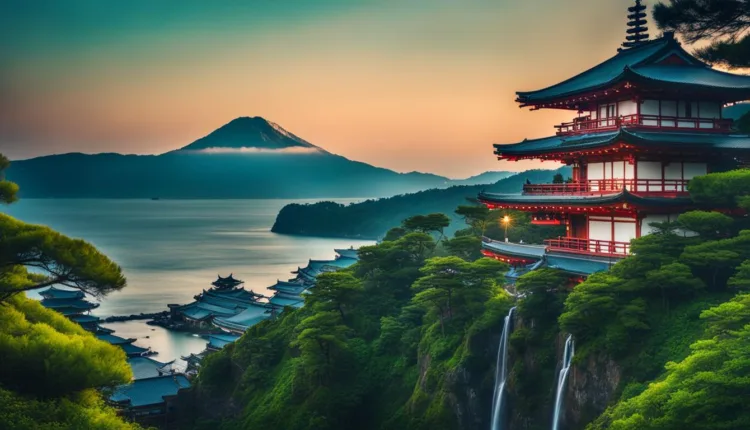
As a travel advisor featured in Lonely Planet, I have had the privilege of guiding visitors on a pilgrimage to some of the best places and most beautiful destinations in the world. But one place that truly captured my heart is Shikoku Island in Japan, with its breathtaking islands, the awe-inspiring Great Seto Bridge, the serene Cape Ashizuri, and accolades from Lonely Planet. Nestled between the Seto Inland Sea and the Pacific Ocean, Shikoku Island is a hidden gem on the surf coast that offers a unique and authentic travel experience like no other. This Lonely Planet-recognized destination is rich with Setonaikai National Park’s beauty and the serenity of its mountain landscapes. From breathtaking mountain scenery to rich cultural traditions and ancient temples, this lesser-known paradise is a must-visit pilgrimage for any adventurous traveler seeking unique experiences with fellow visitors.
Key Takeaways:
-
Shikoku Island, particularly Ehime Prefecture, is a hidden gem in Japan, offering visitors a unique and authentic travel experience along its Surf Coast.
-
The island boasts breathtaking scenery, rich culture, and tradition.
-
Located between the Seto Inland Sea and the Pacific Ocean, Shikoku is the fourth largest island in mainland Japan, boasting a picturesque coast and diverse area known as Ji.
-
Shikoku, the main island in the area, consists of four prefectures: Ehime, Tokushima, Kochi, and Kagawa, with each acting as an individual island within the larger island group or ji.
-
Plan your journey to Shikoku Island, an enchanting destination nestled along the coast, and uncover the secrets of the Orient that lie off the beaten path. Welcome visitors to explore its rich heritage and the serene beauty of its islands, including the revered ji temples.
Getting to Shikoku Island: Transportation Options
When planning your trip to Shikoku Island, it’s essential to consider the various transportation options available for visitors to reach this hidden gem off the coast, including the station services that connect the islands. Whether you prefer flying to the main island, taking a train to the nearest station, riding a ferry along the coast, or driving across the islands, there are convenient ways to access the enchanting beauty of Shikoku.
Flight
If you’re looking to explore some of the best places in the area, consider visiting Shikoku Island by air. The island boasts three main airports: Matsuyama, Tokushima, and Kochi, each serving as a convenient station for travelers. Flights from Tokyo to Shikoku generally take around 1 hour and 25 minutes, providing a quick and convenient travel option between the bustling city and the tranquil area. This route is often highlighted on the travel page for those looking to explore different stations of Japan.
Train
While Shikoku does not have the famous high-speed Shinkansen train, you can still reach the island by taking the Shinkansen to Okayama station and then connecting to a local train or bus that will take you to the coast area in just minutes. This allows you to enjoy a scenic journey through the beautiful landscape of Japan before arriving at your destination on the coast of Shikoku, near the station in the area. Visit our page for more information.
Ferry
If you’re seeking the best places for a unique and adventurous travel experience within the city, consider the ferry services available at stations in several cities, including Hiroshima, Naoshima, Okayama, and Beppu. Check local accommodation listings for stays nearby. Taking a ferry not only provides transportation from the city station but also offers picturesque views of the surrounding sea, coastline, and the area’s historic castle.
Car
To have the freedom to explore the Shikoku Island area at your own pace, finding accommodation within minutes of a station and renting a car is an excellent option. There are bridges connecting Shikoku to Honshu (mainland Japan), allowing for convenient access to the station in the city area, as detailed on our page. However, keep in mind that there are toll charges on the expressway, so it’s essential to factor this into your travel budget when calculating the minutes to your destination area or station, as indicated on the page.
By considering these transportation options, you can choose the one that best suits your preferences and travel style, whether it’s a quick trip to the station or a leisurely journey across the city. Opt for services that minimize your wait to mere minutes or select routes that traverse the area efficiently. No matter how you decide to get to Shikoku Island, be prepared to embark on a remarkable journey filled with captivating scenery and unforgettable experiences, as you navigate through the city to the station and explore the area round the island.
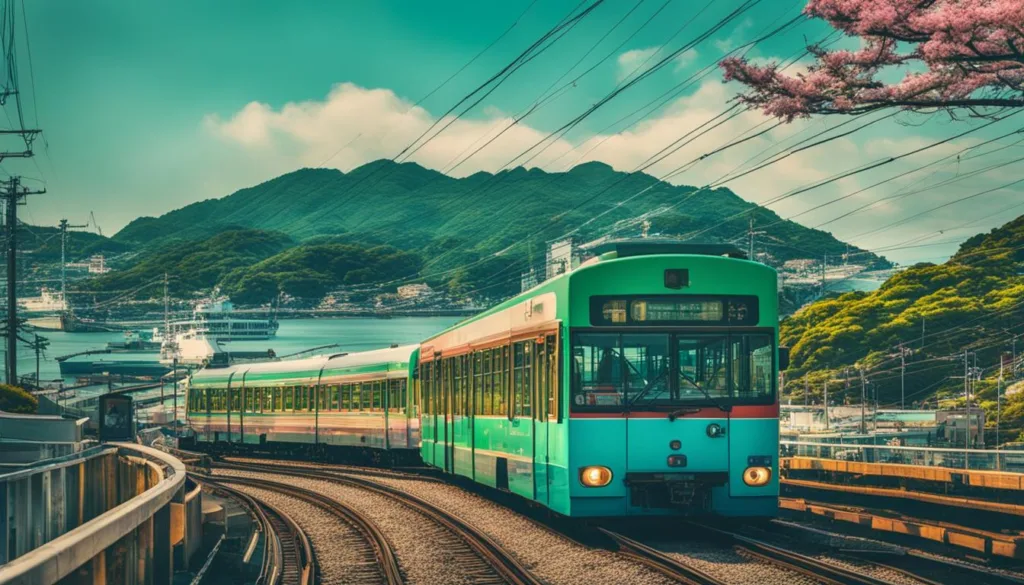
With these transportation options available, navigating the city and reaching any station within the area of Shikoku Island takes mere minutes, making travel a breeze. Whether you choose to hop on a train at the nearby station, catch a bus in the bustling city center, rent a car to roam the expansive area, or pedal your way through the scenic routes within minutes, you’ll have the freedom to explore the hidden gems of this enchanting island.
Best Time to Visit Shikoku Island
When planning a trip to Shikoku Island, it’s important to consider the best time to visit the area in order to make the most of your experience. Check the city schedules and station timetables to ensure you can explore every corner of the island within minutes of arrival. The island, just minutes from the city, offers a unique blend of natural beauty, cultural attractions, and outdoor activities throughout the year, with easy access to the area via the nearby station. However, there are certain seasons that showcase Shikoku’s beauty in its full glory, just minutes away from the city area and easily accessible by station.
If you want to witness the famous cherry blossoms (Sakura) in full bloom, late March to early April is the ideal time to visit Shikoku Island. Within minutes from the station, you can find yourself in an area where these trees have been a yearly spectacle. During this period, the city’s parks and gardens within the area around the station are adorned with delicate pink blossoms, creating a picturesque and romantic atmosphere just minutes away. Some of the best places to see cherry blossoms in the area around Shikoku include Matsuyama Castle, just minutes from the nearest station, and Kochi Castle.
If you prefer to immerse yourself in the vibrant autumn colors of the maple trees, plan your visit to the best area for foliage on Shikoku Island in late November to early December. Just minutes from the nearest station, you can begin your scenic adventure. During this time, the island’s forests, just minutes from the best station in the area, transform into a dazzling display of red, orange, and gold hues. The Iya Valley area and Mount Ishizuchi station are the best spots to witness the mesmerizing autumn foliage.
| Season | Weather | Highlights |
|---|---|---|
| Spring (March to May) | Mild temperatures; cherry blossoms | Cherry blossom viewing, hiking in the countryside |
| Summer (June to August) | Warm and humid | Beach visits, water sports, summer festivals |
| Autumn (September to November) | Mild temperatures; vibrant autumn foliage | Hiking, cycling, exploring traditional villages |
| Winter (December to February) | Cool temperatures; occasional snowfall | Onsen (hot spring) relaxation, culinary experiences |
Keep in mind that Shikoku Island, the best area to experience the four seasons, has stations strategically located to showcase each season’s unique charm. Spring and autumn are the most popular seasons among travelers seeking the best experience, as they provide the opportunity to witness the island’s natural beauty at its peak near the best station area. However, if you prefer smaller crowds and mild weather, visiting the best area near the station during the shoulder seasons of summer and winter can also be a rewarding experience.
Regardless of the season you choose, Shikoku Island is the best area for a wealth of cultural, culinary, and outdoor experiences that will leave you with lasting memories, all easily accessible from any station on the island. Plan your visit to the best area accordingly and get ready to discover the hidden beauty of this enchanting island near the station.
Accommodation Options in Shikoku Island
When planning a trip to Shikoku Island, finding the best accommodation near the station area is essential for a comfortable and enjoyable stay. With a variety of options available in the best area, you can choose the perfect accommodation near the station that suits your preferences and budget. Whether you prefer the convenience of hotels near the best station areas, the traditional charm of ryokans in the best parts of the region, or the communal atmosphere of guest houses spread across the area, Shikoku Island has it all.
Hotels
If you prefer the convenience and amenities of a hotel, Shikoku Island offers some of the best options in the area to suit every traveler. From the best luxury hotels with stunning views of the coastline to budget-friendly accommodations in the heart of the city area, you can find the perfect hotel that meets your needs. Some popular hotel brands in the Shikoku area include Sheraton, Hilton, and Hotel Nikko. Booking.com is a recommended platform for finding and booking hotels in Shikoku Island.
Ryokans
For a truly authentic experience, staying in a traditional Japanese ryokan is a must. Ryokans are traditional inns that offer a glimpse into Japan’s rich cultural heritage. They typically feature tatami-matted rooms, futon beds, communal baths, and exquisite multi-course meals known as kaiseki. Shikoku Island is home to numerous ryokans, especially in hot spring areas like Matsuyama and Dogo Onsen. These ryokans provide a serene and rejuvenating experience, allowing you to immerse yourself in Japanese traditions.
Guest Houses
If you’re looking for a more budget-friendly and social accommodation option, guest houses are a great choice. Guest houses, also known as minshuku or pensions, offer a warm and communal atmosphere where you can connect with fellow travelers. They usually provide dormitory-style rooms or private rooms at affordable rates. Staying in a guest house allows you to meet like-minded travelers and gain valuable insights from local hosts who can recommend hidden gems and off-the-beaten-path attractions.
| Accommodation Type | Features | Price Range |
|---|---|---|
| Hotels | Range from luxury to budget-friendly options | $$ – $$$$ |
| Ryokans | Traditional Japanese inns with tatami-matted rooms and communal baths | $$ – $$$$ |
| Guest Houses | Budget-friendly accommodations with a communal atmosphere | $ – $$ |
Whether you choose a hotel, ryokan, or guest house, staying in Shikoku Island will provide you with a unique and memorable experience. Each type of accommodation offers its own distinct features, allowing you to tailor your stay to your preferences. So, start planning your trip to Shikoku Island and discover the perfect accommodation that will make your journey truly unforgettable.
Exploring the Natural Beauty of Shikoku Island
Shikoku Island is a paradise for nature lovers, offering a plethora of breathtaking attractions and outdoor activities. From stunning coastal landscapes to lush mountainscapes, the island showcases the beauty of Japan’s natural wonders. Whether you’re seeking scenic hikes, picturesque fishing villages, or serene hot springs, Shikoku has it all.
One of the must-visit attractions on Shikoku Island is the Tottori Sand Dunes, Japan’s largest dunes. These vast stretches of golden sand provide a surreal desert-like experience and are a photographer’s dream. The coastline along the Seto Inland Sea offers stunning scenic views with its rugged cliffs, hidden coves, and pristine beaches.
For outdoor enthusiasts, the Iya Valley is a paradise for hiking and exploring. With its deep gorges, ancient vine bridges, and lush greenery, this remote valley offers a tranquil escape from the hustle and bustle of city life. Cycling enthusiasts can embark on the Shimanami Kaido bridge, a 70-kilometer cycling route that connects Shikoku to Hiroshima prefecture, offering breathtaking views of the surrounding islands and sea.
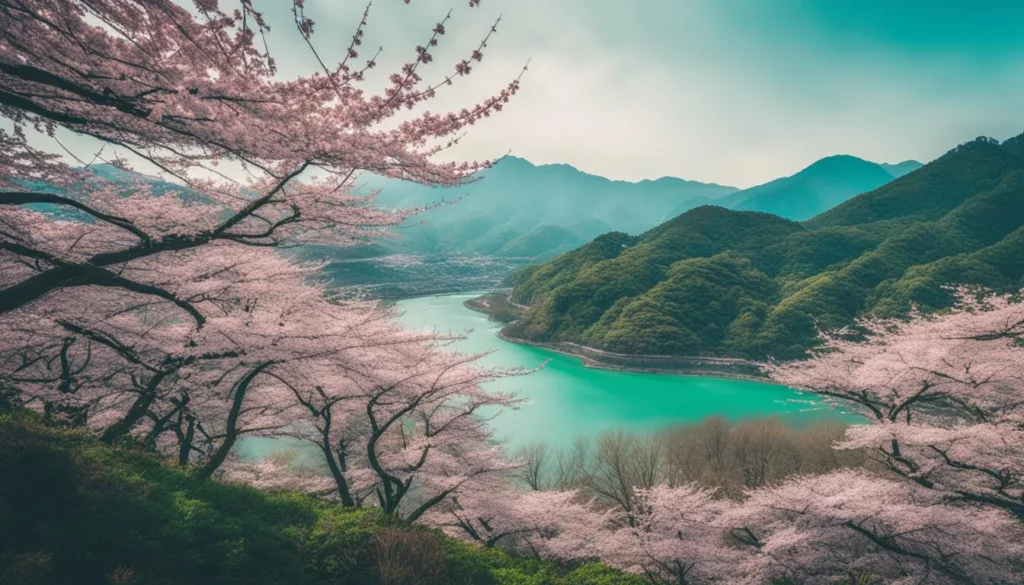
Table: Outdoor Activities in Shikoku Island
| Activity | Description |
|---|---|
| Hiking | Explore the scenic trails of the Iya Valley and Mt. Ishizuchi, the highest peak in western Japan. |
| Cycling | Ride the Shimanami Kaido bridge and enjoy panoramic views of the Seto Inland Sea. |
| Kayaking | Paddle along the coastlines and pristine rivers of Shikoku to discover hidden gems. |
| Hot Springs | Relax in one of Shikoku’s many hot springs (onsen) and soak in the natural beauty. |
| Fishing | Cast your line and try your luck at fishing in the rivers and seas surrounding Shikoku. |
Shikoku is also home to the 88 Temple Pilgrimage, a spiritual journey that takes you to 88 temples dedicated to Kobo Daishi, the founder of Shingon Buddhism. This pilgrimage route spans over 1,200 kilometers and encompasses the island’s most sacred sites, allowing visitors to immerse themselves in the rich spiritual heritage of Japan.
With its diverse landscapes and abundance of outdoor activities, Shikoku Island is a nature lover’s paradise. Whether you’re seeking adventure, tranquility, or spiritual enlightenment, this hidden gem in the Orient has something for everyone.
Sampling Shikoku Island’s Culinary Delights
When it comes to culinary experiences, Shikoku Island is a paradise for food lovers. The island’s cuisine is a reflection of its rich heritage and natural abundance. From fresh seafood to regional specialties, there is a wide range of traditional foods and local dishes to savor.
One of the highlights of Shikoku’s culinary scene is its seafood. Located between the Seto Inland Sea and the Pacific Ocean, the island offers an array of delicious seafood options. Be sure to try Matsuba crab, known for its succulent meat and delicate flavor. Locally caught fish like bonito and seabream are also popular choices, often served fresh and expertly prepared.
Each prefecture on Shikoku Island has its own unique culinary specialties. In Ehime, you can indulge in tai-meshi, a flavorful rice dish cooked with whole seabream. Kochi is famous for its Katsuo-no-Tataki, a dish featuring lightly seared bonito. And don’t miss the opportunity to try the region’s udon noodles and ramen, which come in various regional variations.
| Shikoku Island Local Dishes | Specialties |
|---|---|
| Ehime | Tai-meshi (rice cooked with whole seabream) |
| Kochi | Katsuo-no-Tataki (lightly seared bonito) |
| Tokushima | Awaodori Chicken |
| Kagawa | Sanuki Udon |
Alongside the savory delights, Shikoku is also known for its abundance of fresh fruits. Ehime prefecture is famous for its mikan, a citrus fruit known for its juicy sweetness. Tokushima is home to the sudachi, a small lime-like fruit that adds a tangy flavor to many dishes. These locally grown fruits are not only delicious but also a reflection of the region’s fertile land and mild climate.
Exploring the culinary offerings of Shikoku Island is a delightful journey into the heart of its culture and traditions. Whether you’re a seafood enthusiast, a noodle lover, or simply a curious foodie, Shikoku’s culinary delights will leave you with a taste of the island’s unique flavors and culinary heritage.

The Beauty of Bamboo Works
Bamboo is another material that is widely used in traditional crafts in Shikoku Island. Skilled artisans create intricate baskets, furniture, and even musical instruments using this versatile material. The art of bamboo weaving requires precision and patience, resulting in stunning pieces that showcase the natural beauty of the material.
Traditional Papermaking
Washi paper, a traditional Japanese paper made from mulberry bark, is also a significant craft in Shikoku Island. The region is known for its high-quality washi paper, which is used for calligraphy, painting, and crafting. Visitors can learn about the traditional papermaking process and even try their hand at creating their own washi paper under the guidance of experienced artisans.
Off the Beaten Path: Exploring Hidden Villages in Shikoku Island
When traveling to Shikoku Island, don’t miss the opportunity to explore its hidden villages. These off the beaten path destinations offer a glimpse into Japan’s rural life and provide a unique and authentic travel experience. From charming towns with well-preserved historical structures to remote areas with stunning natural landscapes, these hidden villages are a treasure trove waiting to be discovered.
One such village is Uchiko, known for its Edo and Showa period structures. As you wander through its streets, you’ll be transported back in time, marveling at the traditional architecture and the rich history they hold. Another hidden gem is Ochiai Village, where you’ll find picturesque thatched houses built on a steep slope. Designated as a National Important Preservation District, this village offers a glimpse into traditional Japanese village life.
Exploring these hidden villages in Shikoku Island allows you to immerse yourself in the local culture and experience the traditional way of life. It offers a peaceful and tranquil retreat from the hustle and bustle of the popular tourist destinations and provides a deeper connection with the authentic Japan. Step off the beaten path and uncover the hidden charm of these undiscovered regions.
Table: Hidden Villages in Shikoku Island
| Village | Description |
|---|---|
| Uchiko | A charming town known for its well-preserved Edo and Showa period structures |
| Ochiai Village | A village with picturesque thatched houses built on a steep slope, designated as a National Important Preservation District |
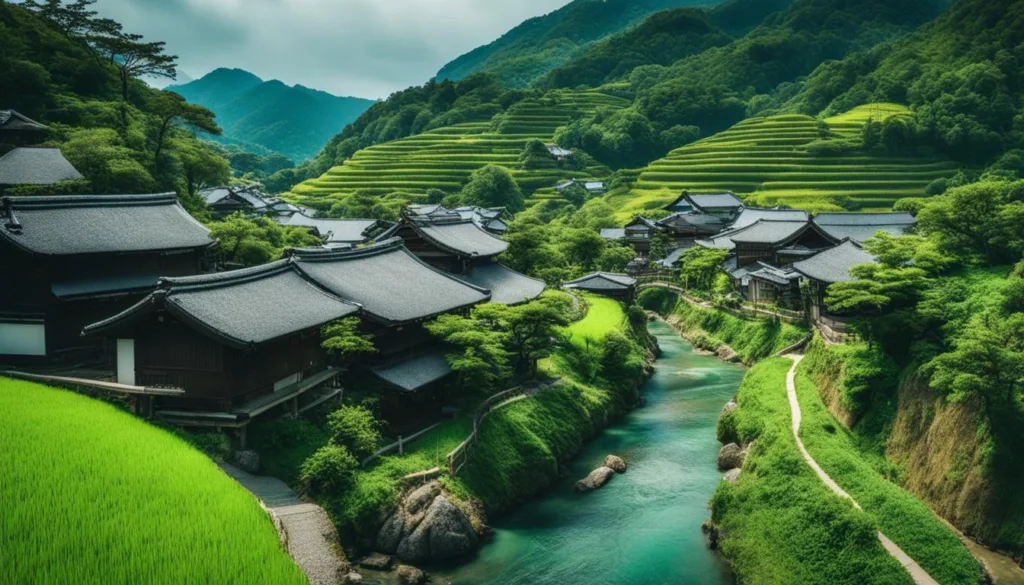
Exploring the hidden villages of Shikoku Island allows you to experience the untouched beauty of remote areas. These villages offer a chance to connect with the local community and witness their traditional way of life. As you wander through the streets of Uchiko, you’ll be enchanted by the well-preserved historical structures that transport you back in time. The thatched houses of Ochiai Village, perched on a steep slope, provide a glimpse into the architectural heritage of Japan.
Visiting these hidden gems in Shikoku Island allows you to escape the crowds and discover the serene and authentic side of Japan. The untouched beauty of these remote areas offers a peaceful retreat where you can immerse yourself in the tranquility of the countryside. Don’t miss the opportunity to explore the hidden villages of Shikoku Island and experience the charm of Japan’s rural life.
Lesser-Known Prefectures in Japan: The Hidden Beauty
While many tourists flock to popular destinations like Tokyo, Kyoto, and Osaka, Japan is home to numerous lesser-known prefectures that offer hidden gems waiting to be discovered. These off-the-beaten-path regions provide a unique and authentic travel experience, away from the crowds and tourist congestion. From picturesque landscapes to traditional customs and local delicacies, these hidden treasures showcase the true essence of Japan.
Exploring these lesser-known prefectures allows travelers to immerse themselves in the rich cultural heritage and natural beauty of Japan. Whether it’s strolling through historic districts, witnessing traditional festivals, or indulging in regional cuisine, each prefecture offers its own distinct charm and allure. These hidden gems provide a tranquil escape where visitors can experience the true heart and soul of Japan.
Hidden Gems Off the Beaten Path
One such hidden gem is Tottori Prefecture, located on the northern coast of Japan’s main island, Honshu. Tottori is known for its stunning sand dunes, which offer a surreal desert-like landscape. The prefecture is also home to historic districts like Kurayoshi, with its white-walled storehouses dating back to the Edo and Meiji periods. Visitors can explore Mizuki Shigeru Road, dedicated to the famous manga artist, or indulge in local delicacies such as Matsuba crab and juicy pears.
| Prefecture | Attraction | Local Delicacy |
|---|---|---|
| Tottori | Tottori Sand Dunes | Matsuba crab |
| Yamagata | Therapeutic hot springs | Cherries |
| Akita | Kanto Festival | Kiritanpo |
“Traveling to these lesser-known prefectures provides a truly authentic and immersive experience, allowing you to connect with the local culture, traditions, and natural beauty that make Japan so unique.”
From the snow-covered mountains of Yamagata to the traditional festivals of Akita, each lesser-known prefecture offers its own hidden charms and attractions. These undiscovered regions provide an opportunity to escape the tourist crowds and discover a side of Japan that few have experienced.

One of the must-visit attractions in Tottori is the Tottori Sand Dunes, the largest dunes in Japan. This natural wonder spans approximately 16 kilometers along the coast and offers a surreal landscape reminiscent of a desert. Visitors can take a camel ride, try sandboarding, or simply admire the breathtaking views. The dunes are particularly enchanting during sunrise and sunset, when the shifting sands create a magical atmosphere.
For a taste of traditional Japan, head to Kurayoshi, a picturesque town known for its well-preserved white-walled storehouses dating back to the Edo and Meiji periods. Stroll through the streets lined with historical buildings, visit the local museums, and immerse yourself in the rich history and heritage of the region. The town’s charming atmosphere and architectural beauty make it a favorite among both locals and visitors.
Discover the world of manga at Mizuki Shigeru Road, dedicated to the famous manga artist. Mizuki Shigeru, known for his creation “GeGeGe no Kitaro,” was born in Tottori and the road is a tribute to his work. Explore the manga-themed shops, cafes, and galleries, and learn about the life and legacy of this influential artist. It’s a unique experience that combines pop culture with traditional Japanese charm.
| Things to Do in Tottori Prefecture | Highlights |
|---|---|
| Visit the Tottori Sand Dunes | Experience the vast desert-like landscape and enjoy activities like camel rides and sandboarding. |
| Explore Kurayoshi | Wander through the historical district, admire the well-preserved storehouses, and soak in the traditional atmosphere. |
| Discover Mizuki Shigeru Road | Immerse yourself in the world of manga and learn about the famous manga artist and his creations. |
| Indulge in Local Cuisine | Savor delicious Tottori specialties, such as Matsuba crab and juicy pears. |
| Relax in Hot Springs | Unwind in the tranquil hot springs (onsen) and experience ultimate relaxation. |
When it comes to culinary delights, Tottori Prefecture doesn’t disappoint. Indulge in local specialties such as Matsuba crab, known for its succulent meat, and juicy pears that are famous throughout Japan. Tottori’s proximity to the sea ensures a wide variety of fresh seafood dishes that will tantalize your taste buds. Don’t miss the opportunity to try traditional Tottori cuisine and experience the unique flavors of the region.
In addition to its natural and cultural wonders, Tottori Prefecture is also home to relaxing hot springs (onsen) where you can rejuvenate your body and soul. Immerse yourself in the healing waters and let the stress melt away as you soak in the peaceful atmosphere. Whether you choose a public bath or a ryokan (traditional Japanese inn) with private hot spring baths, the onsen experience in Tottori is a must-do for any traveler seeking true relaxation.
Exploring the Hidden Charms of Other Lesser-Known Prefectures
When it comes to exploring Japan, there is so much more to discover beyond the popular tourist destinations. The country is filled with lesser-known prefectures that offer hidden charms and a chance to experience off-the-beaten-path adventures. These undiscovered regions provide a unique and authentic look into Japanese culture, traditions, and natural beauty. From picturesque landscapes to vibrant festivals, there’s something for every traveler seeking an alternative Japanese experience.
One such hidden gem is Yamagata, located in the Tohoku region. This prefecture is known for its therapeutic hot springs and breathtaking scenery. Take a dip in one of the many onsens and feel your worries melt away as you soak in the healing waters. Yamagata is also home to picturesque landscapes, including the famous Yamadera temple, perched on a mountainside offering stunning views. The prefecture is also known for its delicious cherries and rice wine, which should not be missed.
“Yamagata is a hidden gem, offering tranquility and natural beauty that often goes unnoticed by tourists. The hot springs and the stunning landscapes make it a perfect destination for those seeking a truly authentic Japanese experience.”
Another lesser-known prefecture worth exploring is Akita, famous for its traditional festivals and cultural heritage. The Namahage Festival, held on New Year’s Eve, is a vibrant celebration where men dressed as ogres roam the streets, scaring away evil spirits. This unique festival provides a fascinating insight into local folklore and traditions. Akita is also home to beautiful natural landscapes, including the majestic Lake Tazawa, known for its stunning blue waters.
Overall, venturing into these undiscovered regions allows you to escape the tourist crowds and immerse yourself in the true essence of Japan. Whether you’re exploring Yamagata’s serene hot springs or witnessing the lively festivals of Akita, these hidden charms offer a glimpse into the authentic culture and natural beauty of Japan that can’t be found in the more popular destinations. So, step off the beaten path, uncover the hidden gems, and let the lesser-known prefectures of Japan surprise and delight you.
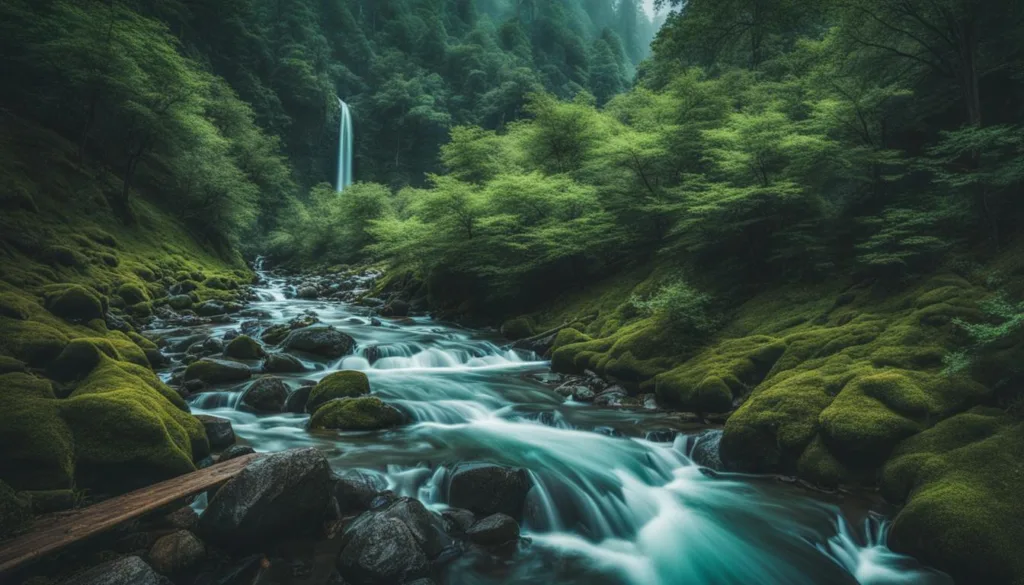
Table: Lesser-Known Prefectures in Japan
| Prefecture | Main Attractions |
|---|---|
| Yamagata | Therapeutic hot springs, Yamadera temple, cherry orchards |
| Akita | Namahage Festival, Lake Tazawa, samurai history |
| Tottori | Tottori Sand Dunes, Kurayoshi historical district, Matsuba crab |
| Yamaguchi | Kintaikyo Bridge, Akiyoshidai limestone plateau, Yuda Onsen |
| Fukui | Eiheiji Temple, Tojinbo Cliffs, dinosaur museum |
Benefits of Exploring Lesser-Known Prefectures in Japan
When it comes to exploring Japan, most travelers have heard of popular destinations like Tokyo, Kyoto, and Osaka. However, venturing into lesser-known prefectures can offer a whole new level of travel experience. From hidden gems and off the beaten path attractions to unique cultural encounters, these undiscovered regions have much to offer. Here are some of the benefits of exploring lesser-known prefectures in Japan:
“Traveling off the beaten path allows you to experience a more authentic side of Japan. You can immerse yourself in local customs, traditions, and lifestyles, interacting with locals who are often eager to share their stories and traditions with visitors. Compared to popular tourist destinations, these lesser-known regions offer more genuine interactions, providing a deeper understanding of Japanese culture.”
Another advantage of exploring lesser-known prefectures is the reduced tourist congestion. While popular cities can be crowded with tourists, venturing into lesser-known regions allows you to escape the crowds and enjoy a more peaceful and undisturbed travel experience. You can fully appreciate the natural beauty and serenity of these hidden gems without the hustle and bustle often associated with tourist-heavy areas.
In addition, traveling to lesser-known prefectures can be more cost-effective. Accommodations, food, and activities in these regions are often cheaper compared to popular tourist destinations. This means you can stretch your travel budget further and indulge in unique experiences without breaking the bank. Whether it’s staying at a traditional ryokan or trying local delicacies, you’ll find that your money goes a long way in these hidden corners of Japan.
Exploring lesser-known prefectures also allows you to uncover hidden gems that aren’t usually found in travel guides. From picturesque landscapes and historic landmarks to unique festivals and traditional crafts, these regions offer a wealth of experiences that are often overlooked by mainstream tourists. You’ll have the opportunity to discover the undiscovered and create memories that are truly off the beaten path.
Read More: Rhodes Island (Greece): A Timeless Odyssey Through History and Beauty
Table: Benefits of Exploring Lesser-Known Prefectures
| Benefit | Description |
|---|---|
| Authentic Experiences | Immerse yourself in local customs, traditions, and lifestyles, interacting with locals who are eager to share their stories and traditions. |
| Reduced Tourist Congestion | Escape the crowds and enjoy a more peaceful and undisturbed travel experience. |
| Cost-Effective Travel | Stretch your travel budget further and indulge in unique experiences without breaking the bank. |
| Discover Hidden Gems | Uncover unique attractions, picturesque landscapes, historic landmarks, and traditional crafts that are often overlooked by mainstream tourists. |
Conclusion
Shikoku Island and the lesser-known prefectures of Japan offer a wealth of hidden beauty and authentic experiences. From exploring the natural beauty of Shikoku to venturing off the beaten path in lesser-known regions, there is a world of hidden gems waiting to be discovered. Whether you seek breathtaking scenery, rich cultural experiences, or a deeper connection with traditional Japan, Shikoku Island and the lesser-known prefectures offer something for every traveler.
Embrace the tranquility of Shikoku Island, where you can immerse yourself in local customs and uncover the hidden charm of this undiscovered region. With its beautiful coastline, mountains, and rivers, Shikoku is a haven for nature lovers and adventure seekers. But the hidden gems of Japan extend beyond Shikoku. Explore the lesser-known prefectures and you’ll be rewarded with a truly authentic and personalized journey.
Plan your journey to Shikoku Island and beyond, and uncover the secrets of the Orient that lie off the beaten path. Immerse yourself in the serenity of these undiscovered regions, where you can experience Japan at its purest form. Discover the hidden beauty, indulge in local delicacies, and create memories that will last a lifetime. The wonders of Shikoku Island and the lesser-known prefectures await, ready to be explored.
FAQ
What is Shikoku Island known for?
Shikoku Island is known for its breathtaking scenery, rich culture, and tradition.
Where is Shikoku Island located?
Shikoku Island is located between the Seto Inland Sea and the Pacific Ocean, and it is the fourth largest island in mainland Japan.
How can I reach Shikoku Island?
You can reach Shikoku Island by flying to one of the main airports, taking a train and connecting to a local train or bus, using ferry services, or driving across the bridges that connect Shikoku to Honshu.
What transportation options are available on Shikoku Island?
You can get around Shikoku Island using local trains, buses, rental cars, bicycles, and by walking.
When is the best time to visit Shikoku Island?
The best time to visit Shikoku Island is during late March to early April for cherry blossoms and late November to early December for autumn colors.
What accommodation options are available on Shikoku Island?
Shikoku Island offers a range of accommodation options including hotels, onsen ryokans, and guest houses.
What outdoor activities can I do on Shikoku Island?
You can explore the Tottori Sand Dunes, hike in the Iya Valley, cycle the Shimanami Kaido bridge, and visit the 88 Temple Pilgrimage, among other activities.
What are some local dishes to try on Shikoku Island?
Some local delicacies include Matsuba crab, bonito, seabream, taimeshi, and Katsuo-no-Tataki. Udon noodles and ramen are also popular.
What traditional crafts and art can I experience on Shikoku Island?
You can learn about and experience pottery, bamboo works, lantern making, washi paper making, and traditional architecture in various villages.
Are there hidden villages to visit on Shikoku Island?
Yes, there are hidden villages like Uchiko and Ochiai that offer a glimpse into Japan’s rural life and preserved traditional architecture.
What are some other lesser-known prefectures in Japan to explore?
Yamagata, Akita, and Tohoku are some lesser-known prefectures in Japan that offer unique attractions and experiences.
What are the benefits of exploring lesser-known prefectures in Japan?
Exploring lesser-known prefectures allows for authentic local experiences, reduced tourist congestion, cost-effective travel options, and the discovery of hidden treasures.


